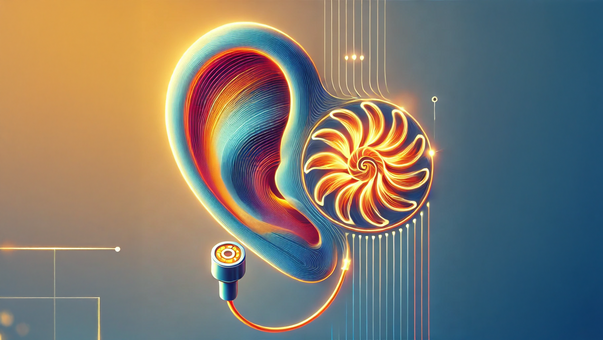

Translated with DeepL
The ear comprises the outer, middle and inner ear. The inner ear contains the fluid-filled cochlea with the important sensory hair cells. These are the receptors of the inner ear that ensure the connection to the brain via the auditory nerve. A person has over 15,000 hair cells in one ear. If these die, they can no longer be saved: The loss is irreversible and there is a risk of hearing loss. The inner ear is therefore a sophisticated, sensitive system that can easily be damaged.
People with mild to profound hearing loss can improve their hearing by amplifying the signals with a hearing aid (see also the article How technology is revolutionising hearing acoustics). People with severe to complete deafness need a cochlear implant. Whether the hearing aid or the cochlear implant is the best solution depends on the number of functioning hair cells.
Deaf people no longer have any hair cells. However, the auditory nerve is almost always preserved. The cochlear implant consists of a microphone attached to the head and a speech processor that transmits digital signals wirelessly to the electrode array surgically inserted into the cochlea. The electrodes stimulate the auditory nerve, which transmits the electrical signals to the brain for interpretation into speech and sound. The cochlear implant creates a technical auditory impression that enables people to understand speech and participate in social life.
If too many of the brain's resources are used to understand a conversation, they will be lacking in other areas of the brain. This is why hospitals now also recommend cochlear implants for 80-year-old patients, as they are a good solution. The procedure is unproblematic in terms of invasiveness and follows a standardised procedure.

"Today, the only treatment option for inner ear loss is a hearing aid or, in extreme cases, a cochlear implant."
Daniel BodmerFar too little attention is paid to the fact that some medications damage the hair cells of the cochlea and therefore the hearing. The effect can be temporary or even permanent. These include aminoglycoside antibiotics, cancer drugs, diuretics, salicylates and antimalarials. Estimates of the prevalence of drug-induced hearing loss in patients - these adverse side effects and reactions are called ototoxicity - vary widely in the literature, ranging from 2 to 25 per cent. Drugs such as cisplatin, which are used in cancer treatments, can damage the hair cells as a side effect and thus lead to irreversible hearing loss. The prevalence of hearing loss following the administration of cisplatin is high, but significantly lower for carboplatin. The use of aminoglycoside antibiotics leads to permanent hearing loss. Aminoglycosides are particularly dangerous for people with a certain mutation in the mitochondrial genome. Even a small dose of the antibiotic can lead to permanent deafness.
Diagnosis and drug treatment of hearing impairment are extremely complex due to the difficulty in accessing the cochlea. This makes it more complicated to systematically determine the correct dosage of active substances. Various companies are currently trying to develop drugs to protect hearing. Daniel Bodmer was also involved in one such start-up. Unfortunately, the project had to be abandoned as the active ingredient was effective in animals but not in humans.
"Hearing loss is not exclusively a symptom of old age. It is important that people become aware of their own hearing loss and are prepared to have it treated at an early stage."
Daniel BodmerHearing aids and cochlear implant systems are two technologies available to both young and old people that can significantly improve their quality of life. These technologies amplify sounds but do not target the underlying molecular defects. Research into the protection of hair cells with drugs is difficult, as drug concentrations in the fluid of the cochlea are often too low to have an effect due to the barrier. It will still take a lot of new findings for these applications to become competitive with existing technologies. The same applies here: The best way to prevent hearing loss is to protect your hearing as much as possible from noise.
Daniel Gygax and Eric Kübler